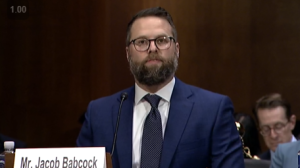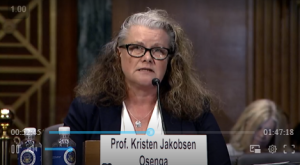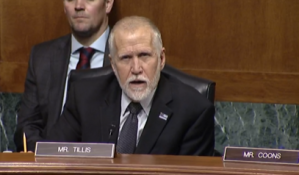The Senate Judiciary Committee’s Subcommittee on Intellectual Property recently held a new hearing focusing on the RESTORE Patent Rights Act, a deceptively simple one-sentence bill that could dramatically reshape patent enforcement in the United States. The hearing highlighted the stark divide between those who believe stronger injunctive relief is needed to protect patent rights and those who warn that presumptive injunctions could harm innovation.
At its core, the RESTORE Act would establish a rebuttable presumption that courts should grant permanent injunctions when patent infringement is found. The key language is as follows:
If . . . the court enters a final judgment finding infringement of a right secured by patent, the patent owner shall be entitled to a rebuttable presumption that the court should grant a permanent injunction with respect to that infringing conduct.
This would partially reverse the Supreme Court’s 15-year-old decision in eBay Inc. v. MercExchange, L.L.C., 547 U.S. 388 (2006) which eliminated the near-automatic granting of injunctions in patent cases and instead required courts to apply a four-factor test considering irreparable harm, adequacy of monetary damages, balance of hardships, and the public interest. Under the proposal, the four factors would (I presume) continue to apply, but with the burden shifted to adjudged infringers to show that they do not support injunctive relief. In my mind, the bill also highlights an aspect of eBay that is not much discussed. The Supreme Court said nothing explicit about whether a presumption of irreparable harm persists — that elimination of even a presumption of irreparable harm came from the Federal Circuit most notably in Robert Bosch LLC v. Pylon Mfg. Corp., 659 F.3d 1142 (Fed. Cir. 2011). In Bosch, the Federal Circuit took the additional step of interpreting eBay to eliminate the presumption of irreparable harm. Overruling Smith Int’l, Inc. v. Hughes Tool Co., 718 F.2d 1573 (Fed. Cir. 1983) (“where validity and continuing infringement have been clearly established, immediate irreparable harm is presumed.”).
The December 18, 2024 hearing was led by Senators Coons and Tillis and included four witnesses.
- Watch the Hearing.
- 2024-12-18_-_testimony_-_babcock
- 2024-12-18_-_testimony_-_osenga
- 2024-12-18_-_testimony_-_contreras
- 2024-12-18_-_testimony_-_landau


Professor Osenga likened patent infringers to squatters who refuse to leave someone’s property but are merely required to pay back rent rather than vacate. She pointed to empirical evidence supporting this concern, citing recent AUTM data showing that exclusive licenses, which typically command higher values, have decreased post-eBay, while lower-valued non-exclusive licenses have increased.
Joshua Landau, representing the Computer & Communications Industry Association, is on the other side of these arguments. Landau presented data suggesting that operating companies can still readily obtain injunctions when they practice their patents, with grant rates only dropping about 2% post-eBay. The real impact, he argued, has been on non-practicing entities that don’t make products themselves, and that he referred to as patent trolls. Landau warned that presumptive injunctions could allow trolls to extract excessive settlements by threatening to shut down entire product lines over minor features.
Professor Jorge Contreras of the University of Utah provided perhaps the most detailed empirical analysis, noting that courts have only rarely authorized “unenjoined infringement” — approximately twice per year in the 15 years following eBay.
My own work shows that during the 15-year period from 2006 to 2021, Courts have authorized continued infringement in exchange for an ongoing royalty after denying a permanent injunction only 32 times. That’s just twice per year across thousands of patent infringement lawsuits in this country. Hardly an avalanche of infringement that will derail the innovation economy.
Prof Contreras does acknowledge that non-practicing entities are much less likely to obtain injunctive relief. He did not discuss the selection bias — that few NPEs request injunctive relief under the current law because it would likely be deemed a frivolous claim. See Kristina M.L. Acri née Lybecker, Injunctive Relief in Patent Cases: The Impact of eBay, HARV. J.L. & TECH. (forthcoming 2025) (patent owners, regardless of their business model, are increasingly reluctant to even seek injunctive relief).
Contreras also suggested that enhanced damages for willful infringement remains a “strong legal mechanism in place to deter what has been called holdout and predatory infringement.” Professor Contreras also pushed back on claims that eBay has made the U.S. an outlier, noting that other jurisdictions like Germany are actually moving toward more flexible approaches to patent injunctions.
A key point of contention was the bill’s likely beneficiaries. Supporters portrayed it as helping “undercapitalized entities” stand up to large corporations. However, critics argued that the main beneficiaries would be patent assertion entities receiving litigation funding from Wall Street, noting that the top 10 patent litigants in 2022 were all non-practicing entities focused on licensing and litigation rather than product development. But as Babcock argued these days the “time, money, and power is now on the side of the infringers.” Of course, that is generally the way of civil litigation — the cost of litigation is only worth if for plaintiffs if the defendant has money to pay the damages.
The hearing also explored constitutional arguments, with supporters citin Article I’s provision for securing “exclusive Rights” to inventors. Professor Contreras pushed back, arguing that while the Constitution gives Congress power to create patents, it does not establish patent rights as constitutionally protected individual rights akin to those in the Bill of Rights.
Several witnesses discussed the international competitiveness angle, with Babcock warning that uncertain patent rights are causing investment to flow overseas. However, Professor Contreras noted that many countries are actually looking to eBay as a model as they develop more flexible approaches to patent injunctions that consider proportionality.
= = =
I want to note that some inventor advocacy groups are opposing the RESTORE Act — arguing that it does not go far enough in protecting patent rights. Rather, the bill would allow a somewhat attenuated eBay to remain the law rather than returning to historical practice. I agree that even under the new approach, the many accused infringers would be able to, for instance, show a lack of irreparable harm.

Is this likely to be passed? If so, when would it take effect?
Not in 2024.
Thank you for the citation to my 2021 article, Dennis! I’ve now completed my empirical study of all patent lawsuits filed in equity between 1790 and 1880, and I can now definitely conclude what I was only able to suggest in my early report of my reading of the approximately 1,500 opinions in 2021. In the 606 cases in which patent owners sought a permanent injunction, the number of times courts applied a four-factor test: Zero (yes, literally, zero). In these cases, courts issued injunctions on a finding of infringement of a patent that survived validity challenges in 91.2% of the cases. I also explain in my forthcoming article reporting on my empirical study the doctrinal approach employed by courts in their opinions. It’s now up on SSRN and here’s the cite:
Adam Mossoff, Injunctions for Patent Infringement: Historical Equity Practice Between 1790–1882, Harvard Journal of Law & Technology (forthcoming 2025), link to papers.ssrn.com
Thanks Adam!
Further to the extended blog text above, how is there logically “a presumption of irreparable harm” [justifying an injunction to shut down a supplier of consumer products] given to a PAE that has no interest in, or capability of, providing the public with such products, and only seeks money damages for acquired patents on invention that it did not invent?
Also noting that expanded money damages for willful infringement are already available.
I think that the logic here is that patent rights are designed to be “exclusive” and our history of property has always seen this right to exclude as the most fundament right within the bundle of rights.
OK, but “exclusive” can mean the right to exclude other than the patent owner from making, selling or importing products covered by the patent. That is, not necessarily the right of a patent owner to prevent the public from obtaining any patented products from anyone. And there were some decisions to that effect long before eBay or the Fed. Cir.
For a modern hypothetical, what if a small pharma company had a controlling patent on the only effective drug for another major fatal epidemic, could not produce it in sufficient quantities, but refused to license it?
Thanks Paul. IMO, you’ve highlighted one of the fundamental tensions in property law – the balance between exclusive rights and public access to resources. The pharmaceutical example you raise is particularly apt. Traditional property law has long recognized limitations on absolute property rights, especially in cases of necessity or public emergency. The doctrine of necessity in property law allows for temporary intrusion on property rights when urgently needed to prevent serious harm. Similarly, eminent domain and other governmental powers can override property rights when public welfare demands it. In the pharmaceutical context, we have additional mechanisms like march-in rights under Bayh-Dole, compulsory licensing provisions under international law, and various regulatory frameworks that can help ensure public access while still respecting patent rights. One key aspect here is that these are structured limitations to the right of exclusion, rather than simply negating those rights altogether. In the background though, we need to recognize that the US has developed an unusually strong property rights regime — perhaps the strongest in history and we can ask if it goes too far and overvalue the right to exclude over other important social values and human needs.
Hello Professor—I think a simple counter example to this argument may be the fair use doctrine in copyright law.
Prior to the current codification of fair use (which says that it’s non-infringement), the fair use doctrine functions more like a defence that forgives someone’s the intrusion upon an author’s exclusive right. Thus, the existence of reasonable/fair use doctrine, which the Supreme Court has sometimes justified on the basis of implied consent that a reasonable author would give, is at least in tension with the notion that an author (or inventor) would always suffer an irreparable harm.
In addition, I am quite skeptical of historical statistics about injunctive relief in patent law. For one, many historical arguments do not adequately address the division of courts of equity and law, and the historical difficulties associated with calculating damages; indeed, the concept of reasonable royalty didn’t even exist until the turn of the 20th century. For another, rules governing equitable relief is not static—it is based on what is equitable, or fair, in light of the circumstances. In my view, relying on what’s equitable or fair in the 1800s—without adequately addressing the social and technological developments over the last 200 years—is not a compelling argument. Nor is a historical argument particularly impactful when an issue of equitable relief does not arise to the level of a constitutional argument, for originalism’s emphasis on historical evidence applies only to matters of constitutional law.
Moreover, I don’t see why laws and standards governing a suit over a unique baseball (and other unique items) is not adequate for patent law.
I digress. In any case, a presumption of irreparable harm does not necessarily mean that there is a lack of adequate remedy at law (e.g., damages may be sufficient), nor does it compel a finding that the patentee had suffered more harm than the infringer/public.
Thanks for a great summary, and, as always, I would love to hear your thoughts!